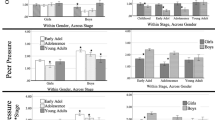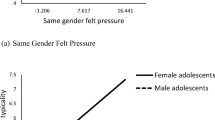Abstract
Most empirical research examining youth’s gender development measures felt pressure to conform to gender norms using a composite value of felt pressure from multiple sources; however, because of the different socialization processes at work from parents, peers, and the self, analyzing these sources separately may elucidate different effects on gender development. Thus, the purpose of this study was to (a) differentiate the effects of perceived gender socialization pressure from parents, peers, and the self on early adolescents’ own- and other-gender typicality, and (b) to examine whether a bi-directional relation between gender typicality and felt pressure is evident when distinguished across sources. With a sample of 212 early adolescents (54% girls; Mage = 11.11 years), felt pressure was found to be distinguishable by socialization source: adolescents’ perceptions of parents, peers, and their own pressures were distinct, and each contributed differently to gender development. Pressure from self and peers were both found to relate concurrently to typicality (i.e., positively to own-gender typicality, negatively to other-gender typicality); only pressure from the self was found to have a longitudinal effect on adolescents’ developing gender identity (i.e., an increase in own-gender typicality). Interestingly, other-gender typicality did not elicit higher felt pressure; in fact, it was negatively related to later felt pressure from the self, suggesting that adolescents may be developing self-acceptance of their levels of gender typicality. The findings suggest that the development of gender identity may involve a complex interplay with various sources of socialization pressures (e.g., parent, peers, self), and may further shift in relation to the adolescent’s own levels of gender typicality.

Similar content being viewed by others
References
Bem, S. L. (1981). Gender schema theory: a cognitive account of sex typing. Psychological Review, 88, 354–364. https://doi.org/10.1037/0033-295x.88.4.354.
Birkett, M., & Espelage, D. L. (2015). Homophobic name‐calling, peer‐groups, and masculinity: the socialization of homophobic behavior in adolescents. Social Development, 24, 184–205. https://doi.org/10.1111/sode.12085.
Clemans, K. H., Derose, L. M., Graher, J. A., & Brooks-Gunn, J. (2010). Gender in adolescence: applying a person-in-context approach to gender identity and roles. In M. R. Stevenson (Ed.), Handbook of gender research in pyschology (pp. 527–557). https://doi.org/10.1007/978-1-4419-1467-5.
Crouter, A. C., Whiteman, S. D., McHale, S. M., & Osgood, D. W. (2007). Development of gender attitude traditionality across middle childhood and adolescence. Child Development, 78, 911–926. https://doi.org/10.1111/j.1467-8624.2007.01040.x.
DeLay, D., Hanish, L. D., Zhang, L., & Martin, C. L. (2017). Assessing the impact of homophobic name calling on early adolescent mental health: a longitudinal social network analysis of competing peer influence effects. Journal of Youth and Adolescence, 46, 955–969. https://doi.org/10.1007/s10964-016-0598-8.
Egan, S. K., & Perry, D. G. (2001). Gender identity: a multidimensional analysis with implications for psychosocial adjustment. Developmental Psychology, 37, 451–463. https://doi.org/10.1037/0012-I649.37.4.45I.
Ewing Lee, E. A., & Troop-Gordon, W. (2011). Peer processes and gender role development: changes in gender atypicality related to negative peer treatment and children’s friendships. Sex Roles, 64, 90–102. https://doi.org/10.1007/s11199-010-9883-2.
Gelman, S. A., Taylor, M. G., Nguyen, S. P., Leaper, C., Bigler, R. S., & Overton, W. E. (2004). Mother-child conversations about gender: understanding the acquisition of essentialist beliefs. Monographs of the Society for Research in Child Development, 69, 1–142. https://doi.org/10.1111/j.1540-5834.2004.06901001.x.
Hill, J. P., & Lynch, M. E. (1983). The intensification of gender-related role expectations during early adolescence. In Girls at puberty (201–228). https://doi.org/10.1007/978-1-4899-0354-9_10.
Hu, L., & Bentler, P. M. (1999). Cutoff criteria for fit indexes in covariance structure analysis: conventional criteria versus new alternatives. Structural Equation Modeling: A Multidisciplinary Journal, 6, 1–55. https://doi.org/10.1080/10705519909540118.
Jewell, J. A., & Brown, C. S. (2014). Relations among gender typicality, peer relations, and mental health during early adolescence. Social Development, 23, 137–156. https://doi.org/10.1111/sode.12042.
Kane, E. W. (2006). No way my boys are going to be like that!. Gender & Society, 20(2), 149–176. https://doi.org/10.1177/0891243205284276.
Kohlberg, L. A. (1966). A cognitive-developmental analysis of children’s sex role concepts and attitudes. In E. E. Maccoby (Ed.), The development of sex differences (pp. 82–173). Stanford, CA: Stanford University Press.
Leaper, C., & Brown, C. S. (2008). Perceived experiences with sexism among adolescent girls. Child Development, 79, 685–704. https://doi.org/10.1111/j.1467-8624.2008.01151.x.
Leaper, C. (2014). Gender and social-cognitive development. In Handbook of child psychology and developmental science: Vol. II (pp. 806–853). https://doi.org/10.1002/9781118963418.childpsy219.
Liben, L. S., & Bigler, R. S. (2002). Gender constructivism reconsidered. Monographs of the Society for Research in Child Development, 67, 22–39. https://doi.org/10.1111/1540-5834.t01-1-00190.
Martin, C. L., Andrews, N. C. Z., England, D. E., Zosuls, K., & Ruble, D. N. (2017). A dual identity approach for conceptualizing and measuring children’s gender identity. Child Development, 88, 167–182. https://doi.org/10.1111/cdev.12568.
Martin, C. L., & Dinella, L. M. (2012). Congruence between gender stereotypes and activity preference in self-identified tomboys and non-tomboys. Archives of Sexual Behavior, 41, 599–610. https://doi.org/10.1007/s10508-011-9786-5.
Martin, C. L., & Halverson, C. F. (1981). A schematic processing model of sex typing and stereotyping in children. Child Development, 52, 1119 https://doi.org/10.2307/1129498.
Martin, C. L., & Ruble, D. (2004). Children’s search for gender cues: cognitive perspectives on gender development. Current Directions in Psychological Science, 13, 67–70. https://doi.org/10.1111/j.0963-7214.2004.00276.x.
Martin, C. L., Ruble, D. N., & Szkrybalo, J. (2002). Cognitive theories of early gender development. Psychological Bulletin, 128, 903–933. https://doi.org/10.1037//0033-2909.128.6.903.
McHale, S. M., Crouter, A. C., & Whiteman, S. D. (2003). The family contexts of gender development in childhood and adolescence. Social Development, 12, 125–148. https://doi.org/10.1103/PhysRevE.51.237.
McHale, S. M., Kim, J. Y., Dotterer, A. M., Crouter, A. C., & Booth, A. (2009). The development of gendered interests and personality qualities from middle childhood through adolescence: a biosocial analysis. Child Development, 80, 482–495. https://doi.org/10.1111/j.1467-8624.2009.01273.x.
Menon, M., Menon, M., Cooper, P. J., Pauletti, R. E., Tobin, D. D., Spatta, B. C., …Perry, D. G. (2017). Do securely and insecurely attached children derive well-being from different forms of gender identity? Social Development, 26, 91–108. https://doi.org/10.1111/sode.12191.
Muthén, L. K., & Muthén, B. O. (1998–2013). Mplus user’s guide. Los Angeles, CA: Muthén & Muthén.
O’Sullivan, L. F., & Thompson, A. E. (2014). Sexuality in adolescence. In D. L. Tolman, L. M. Diamond, J. A. Bauermeister, W. H. George, J. G. Pfaus & L. M. Ward (Eds.), APA handbook of sexuality and psychology, Vol. 1: Person-based approaches (pp. 433–486). Washington D.C.: APA. https://doi.org/10.1037/14193-015.
Pascoe, C. J. (2014). Dude, you’re a fag: masculinity and sexuality in high school (2nd ed.). University of California Press. https://doi.org/10.1007/s13398-014-0173-7.2.
Pauletti, R. E., Cooper, P. J., & Perry, D. G. (2014). Influences of gender identity on children’s maltreatment of gender-nonconforming peers: a person × target analysis of aggression. Journal of Personality and Social Psychology, 106, 843–866. https://doi.org/10.1037/a0036037.
Pauletti, R. E., Menon, M., Cooper, P. J., Aults, C. D., & Perry, D. G. (2017). Psychological androgyny and children’s mental health: a new look with new measures. Sex Roles, 76, 705–718. https://doi.org/10.1007/s11199-016-0627-9.
Rogers, L. O. (2018). “I’m kind of a feminist”: using master narratives to analyze gender identity in middle childhood. Child Development, 1–18. https://doi.org/10.1111/cdev.13142.
Smith, T. E., & Leaper, C. (2005). Self-perceived gender typicality and the peer context during adolescence. Journal of Research on Adolescence, 16(1), 91–103. https://doi.org/10.1111/j.1532-7795.2006.00123.x.
Spencer, M. B., Dupree, D., & Hartmann, T. (1997). A phenomenological variant of ecological systems theory (PVEST): a self-organization perspective in context. Development and Psychopathology, 9, 817–833. https://doi.org/10.1017/S0954579497001454.
Steinberg, L., & Monahan, K. C. (2007). Age differences in resistance to peer influence. Developmental Psychology, 43, 1531–1543. https://doi.org/10.1037/0012-1649.43.6.1531.
Steinberg, L., & Morris, A. S. (2001). Adolescent development. Annual Review of Psychology, 52, 83–107. https://doi.org/10.1146/annurev.psych.52.1.83.
Tam, M. J., Jewell, J. A., & Brown, C. S. (2019). Gender-based harassment in early adolescence: group and individual predictors of perpetration. Applied Developmental Psychology, 62, 231–238. https://doi.org/10.1016/j.appdev.2019.02.011.
Thomas, R. N., & Blakemore, J. E. O. (2013). Adults’ attitudes about gender nonconformity in childhood. Archives of Sexual Behavior, 42(3), 399–412. https://doi.org/10.1007/s10508-012-0023-7.
Thompson, J., Coovert, M., & Stormer, S. M. (1999). Body image, social comparison, and eating disturbance: a covariance structure modeling investigation. International Journal of Eating Disorders, 26, 43–51. https://doi.org/10.1002/(SICI)1098-108X(199907)26:1%3C43::AID-EAT6%3E3.0.CO;2-R.
Tobin, D. D., Menon, M., Menon, M., Spatta, B. C., Hodges, E. V. E., & Perry, D. (2010). The intrapsychics of gender: a model of self-socialization. Psychological Review, 117, 601–622. https://doi.org/10.1037/a0018936.
Toomey, R. B., Card, N. A., & Casper, D. M. (2014). Peers’ perceptions of gender nonconformity: associations with overt and relational peer victimization and aggression in early adolescence. Journal of Early Adolescence, 34, 463–485. https://doi.org/10.1177/0272431613495446.
Tylka, T. L. (2011). Refinement of the tripartite influence model for men: dual body image pathways to body change behaviors. Body Image, 8, 199–207. https://doi.org/10.1016/J.BODYIM.2011.04.008.
Umaña-Taylor, A. J., Yazedjian, A., & Bámaca-Gómez, M. (2004). Developing the ethnic identity scale using Eriksonian and social identity perspectives. Identity: An International Journal of Theory and Research, 4, 9–38. https://doi.org/10.1207/s1532706xid0401_2.
Way, N. (2011). Deep secrets: boys’ friendships and the crisis of connection. https://doi.org/10.1086/674714.
Xiao, S. X., Cook, R. E., Martin, C. L., & Nielson, M. G. (2019). Characteristics of preschool gender enforcers and peers who associate with them. Sex Roles, Online First. https://doi.org/10.1007/s11199-019-01026-y.
Yu, C., Zuo, X., Blum, R. W., Tolman, D. L., Kågesten, A., Mmari, K., …Lou, C. (2017). Marching to a different drummer: a cross-cultural comparison of young adolescents who challenge gender norms. Journal of Adolescent Health, 61, S48–S54. https://doi.org/10.1016/j.jadohealth.2017.07.005.
Yunger, J. L., Carver, P. R., & Perry, D. G. (2004). Does gender identity influence children’s psychological well-being? Developmental Psychology, 40, 572–582. https://doi.org/10.1037/0012-1649.40.4.572.
Zosuls, K. M., Andrews, N. C. Z., Martin, C. L., England, D. E., & Field, R. D. (2016). Developmental changes in the link between gender typicality and peer victimization and exclusion. Sex Roles, 75, 243–256. https://doi.org/10.1007/s11199-016-0608-z.
Authors’ Contributions
R.E.C. conceived of the study, performed the statistical analysis, and drafted the manuscript; M.G.N. aided in conceptualization and helped draft the manuscript; C.L.M. participated in its design and participated in the interpretation of the data; D.D. designed the study, conducted data collection, and participated in the interpretation of the data. All authors read and approved the final manuscript.
Data Sharing Declaration
The datasets generated and/or analyzed during the current study are not publicly available but are available from the corresponding author upon reasonable request.
Funding
Funding for this research was provided by the T. Denny Sanford School of Social and Family Dynamics.
Author information
Authors and Affiliations
Corresponding author
Ethics declarations
Conflict of Interest
The authors declare that they have no conflict of interest.
Ethical Approval
All procedures performed in studies involving human participants were in accordance with the ethical standards of the institutional and/or national research committee (Arizona State University IRB, STUDY00001416) and with the 1964 Helsinki declaration and its later amendments or comparable ethical standards.
Informed Consent
Informed consent was obtained for all individual participants included in the study.
Additional information
Publisher’s note Springer Nature remains neutral with regard to jurisdictional claims in published maps and institutional affiliations.
Rights and permissions
About this article
Cite this article
Cook, R.E., Nielson, M.G., Martin, C.L. et al. Early Adolescent Gender Development: The Differential Effects of Felt Pressure from Parents, Peers, and the Self. J Youth Adolescence 48, 1912–1923 (2019). https://doi.org/10.1007/s10964-019-01122-y
Received:
Accepted:
Published:
Issue Date:
DOI: https://doi.org/10.1007/s10964-019-01122-y




